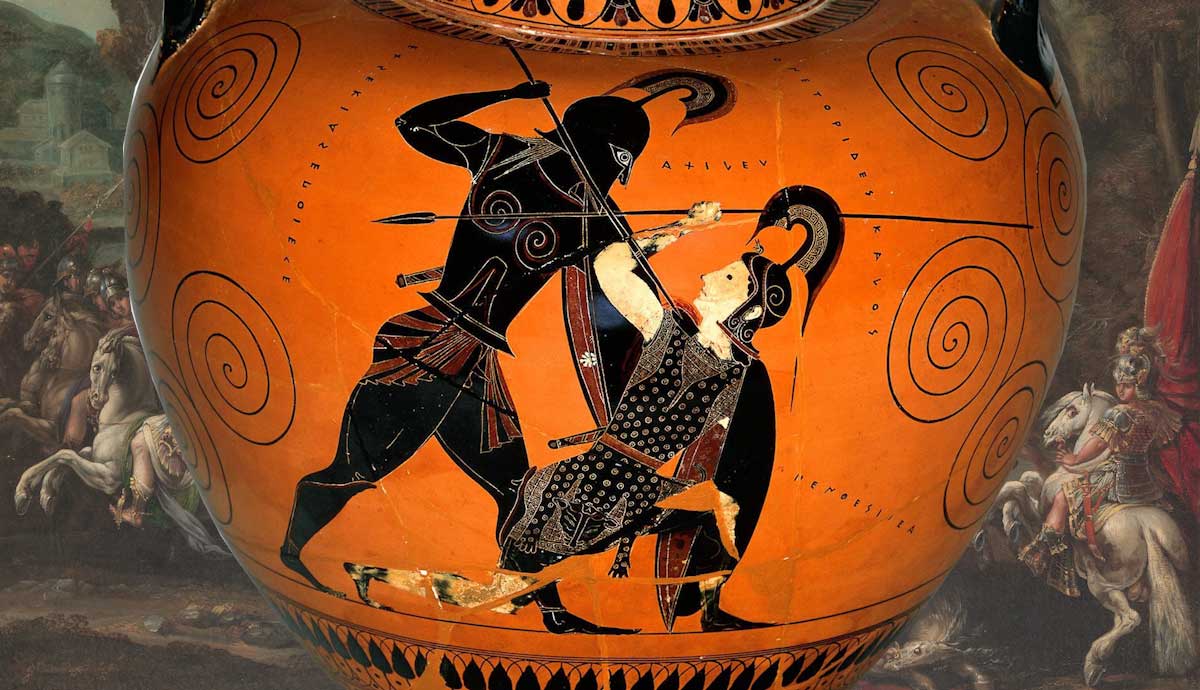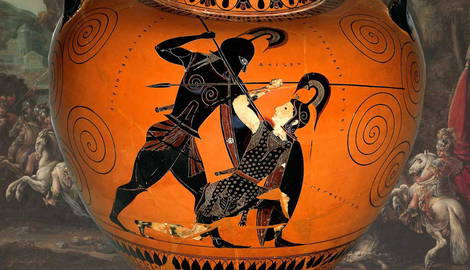
When people think of ancient mythology and the warriors that occupied it, what may come to mind are the likes of Jason and the Argonauts, Achilles, Heracles, Theseus, and other great heroes. Although the ancient imaginary was indeed dominated by the presence of male warriors, just beyond the known Mediterranean world were fierce female warriors that could stand up to the greatest of these men. These warriors were the Amazons. Garnering a reputation for their bravery and combat prowess, tales of Amazons would forever be ingrained in the collective conscience of ancient Greece.
Amazon Warrior Women in Greek Mythology

Amazons were believed to be the daughters of Ares, the god of war. Figuratively or not the offspring of Ares, they were indeed fierce warriors with a skill for war, as evidenced in Greek mythology. Having escaped from the degradation, suppression, subjugation, assault, and murder that the women of the Greek world faced regularly, the Amazons formed their own nation. A nation that excluded the presence of men. A nation where women were given the potential for unbound growth as warriors. Near the Black Sea and beyond the known Mediterranean world, the Amazon nation would be named Themiskyra. Though Themiskyra was the most recognized city-state of the Amazons in mythology, it was not the only place occupied by them. Cities such as Ephesus, Cyme, Sinope, Priene, Myrina, Lesbos, and Mytilene were credited to the Amazons as well.
Usually on the defensive, the Amazons would consistently be at the mercy of male aggression and conquest. With that being said, did the myth derive from the lips and minds of oppressed females to comfort themselves in a patriarchal world? Or did the myth serve as a tale demonstrating the superiority of males over the strongest of females? Or were the Amazons a real race of warrior women? No matter their original purpose in Greek mythology, the Amazons would stand up to the likes of demigods, kings, and nations.
5 Greek Myths with Amazon Women
1. Queen Hippolyta and the Amazons vs. Heracles

The ninth labor of Heracles conferred on him by King Eurystheus required Heracles to travel to the Amazon island of Themyskira to recover the golden girdle of Hippolyta, queen of the Amazons. The looming violence of Heracles’ arrival was subverted when Hippolyta surprisingly welcomed Heracles with open arms. However, the doomed fate of the Amazon queen was sealed.
Unbeknownst to Hippolyta, Hera, queen of the Olympians, interfered in the matter. Disguising herself as an Amazon warrior, Hera roused the Amazons into believing that Heracles and his shipmates were attempting to abduct Hippolyta. Showing loyalty to their queen, the Amazons attacked Heracles’ ship. A great battle took place that resulted in the death of Hippolyta at the hands of Heracles. Notably, another story suggests that Hippolyta fell at the hands of her sister Queen Penthesilea accidentally. While the Amazons were temporarily defeated, Heracles made haste to leave Themyskira and the island’s deadly occupants with Hippolyta’s girdle in hand, completing his ninth labor.
2. Queen Antiope and Theseus’ Abduction

Following the murder of Hippolyta, another controversial story took place: the abduction of Amazon Queen Antiope, the sister of Hippolyta and Penthesilea. There are three significant versions of what happened.
The first story suggests that Antiope willingly boarded the ship of Heracles after the murder of Hippolyta due to being in love with Theseus. Antiope and Theseus would marry in Athens and would even have a child together. However, the Amazons would attack Athens in an attempt to rescue their thought to be abducted queen and retrieve Queen Hippolyta’s girdle. Facing her beloved sisters, Antiope would side with Theseus and the Athenian army to protect the city.
In the second story, Antiope was indeed abducted against her will. It is believed that upon the Amazons’ arrival, Antiope sided with her sisters in arms and attacked Athens to escape the grasp of Theseus.
The last significant story suggests that Antiope was in love with Theseus but did not side with him upon the Amazons’ arrival. In this version, Antiope willingly left her fellow Amazons for Theseus, but Theseus discarded her in favor of Phaedra. Enraged, Antiope plotted to kill all the guests at the wedding of Theseus and his newly beloved wife, Phaedra. It would take the efforts of Theseus, Heracles, and the Athenian army to stop Antiope’s warranted rage. Antiope meets her end in all three variations, as customary in stories with Amazons.
3. Queen Penthesilea Duels with Achilles

When people think of Achilles, the first thing that often comes to mind is his reputation as the greatest warrior and hero of the Trojan War. Indeed, Achilles was one of the most feared warriors in history, but there was one warrior who dared face him with delight and defeat him, Queen Penthesilea.
Aiding King Priamos after the death of Hector, Penthesilea decided the Trojan War needed the intervention of the Amazons. Penthesilea, along with her fellow sisters, rampaged through the Greek lines, slaughtering every soldier that stood in their way. The actions of Penthesilea and the Amazons did not go unnoticed. It was only a matter of time before Achilles and Penthesilea would challenge one another on the battlefield. After an epic confrontation, Penthesilea would go on to kill Achilles in combat. However, as Greek gods are always scheming, Zeus brought Achilles back from death, and Achilles killed Penthesilea. It is suggested that Achilles wept over the death of Pentheslea in admiration of her courage and beauty. Achilles would even kill Thersites, a fellow Greek soldier who dared to mock his mourning.
4. Queen Thalestris’ Attempted Seduction of Alexander the Great

In a world defined by war and conquest, only the strongest and most cunning could thrive. Knowing the tribulations of the ancient world, Queen Thalestris wanted to breed a race of children that would be able to navigate such a world with relative ease. Who would be more fitting for an Amazon queen than Alexander the Great, conqueror of most of the known world? Legend has it that Queen Thalestris greeted Alexander with 300 Amazon warriors, hoping he would father a warrior as great as him.
However, as with most legends, there is a lot of speculation involved, and the academic community, both ancient and modern, rejects that the story actually happened. Still, there is evidence that a Scythian king offered his daughter as a wife to Alexander.
5. Queen Myrina’s Conquest of Atlantians and Gorgons

According to Diodorus Siculus, Queen Myrina was an Amazon whose name spread throughout Greece and Egypt. With an army of thirty thousand infantry, three thousand cavalry, and ruthless tactics, cities would surrender their land willingly to Myrina and her Amazons without conflict. Traveling to the mythical island of Atlantis, Myrina would destroy the city of Cyrenê. Making peace with the Atlantians after the brutal conquest, Myrina would attempt to aid Atlantis and rid it of the neighboring Gorgons. Notably, Diodorus rejected the idea that the Gorgons were monsters with snakes on their heads who, like the famous Gorgon Medusa, could turn mortals into stone. Instead, he favored the idea that Gorgons were a nation of warring tribal women.
The stories are divided between Myrina exterminating every Gorgon and her failing to accomplish her mission. Eventually, Myrina would lead her army toward Egypt and befriend Horus, the Egyptian god-pharaoh. Their partnership would lead to the defeat of the Bedouins, the Syrians, and west Asia. Despite all her conquests, Myrina would die in battle at the hands of Thracians and Scythians.
How to Spot an Amazon in Greek Art

To identify Amazon warrior women in Greek art, one has to ask a couple of questions. What are the characters wearing? And how are the characters displayed among the mediums?
Originally, the Amazons were modeled similarly to the goddess of war and wisdom, Athena. The Amazons would often be equipped with their signature labrys axe, bow, spear, a half-shield, and light armor. As time went on, Amazons were modeled more like the goddess of hunt and wilderness, Artemis. Wearing a dress, the Amazons were given what was believed to be a feminine characteristic to further differentiate them from their male counterparts. As the Greeks were exposed to foreign territories or the Other around 450 BCE, Amazons took the form of Scythian archers and Persians. Amazons would be depicted wearing caps, decorated trousers, and riding horses from then on.
After hearing about how Amazons destroyed mythological cities and armies, faced the most powerful demigods, and earned the respect of nations, you would expect the Amazons to hold a favorable position in Greek art, right? However, if you scroll back up, you will recognize a pattern among the Greek amphorae. A defining and underserved characteristic of Amazons in Greek art is that they are wounded, looking up to the man, and in their most vulnerable state.
Were the Amazon Warrior Women Based in Reality?

As with most myths, scholars originally thought Amazons were a figment of Greek imagination. However, it is likely that the myths of the Amazons were based in reality.
According to a legend relayed by Herodotus, the Amazons were confronted by the Greeks near Thermodon, a river in modern-day Turkey. Having defeated the Amazons, the Greeks took some of them prisoner and attempted to sail home with them. However, the Amazons rebelled and killed all of the Greek soldiers onboard. Amazons would eventually land on the shore of Scythia. After brief altercations with Scythian warriors, Amazons and Scythian men would establish intimate relations. The offspring of such relations would be called the Sauromatians. The Scythians would eventually call these mighty warriors ‘oiorpata’, ‘the killers of men’.

Despite the fanciful nature of the legend, archaeological evidence continues to verify that Sauromatian females were indeed warriors buried with full sets of weapons and sacrificed horses. Despite modern scholars often identifying the Amazons with Scythian women, if Herodotus’ ethnographic words are to be taken seriously — undoubtedly a big leap — Amazons believed themselves to be nothing like Scythian women. So, conceivably the Sauromatians were descendants of the Scythians and some people that inspired tales of Amazons with their valuing of warrior women. Or Sauromatian women inspired the legends of Amazons altogether.
Nevertheless, in the end, the tales of the Amazons show that women can be just as fierce, courageous, and skilled as any great man in history.










